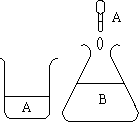Chemiluminescence of Tris(2,2'-Bipyridyl) Ruthenium(II) Ion
- Page ID
- 221925
Chemical Concept Demonstrated
- Luminescence occurring during a reduction reaction
Demonstration
Solution A:
SolutionB:
|  | Using a pipette, add solution A to B. |
Observations
When solution A is added to the flask, orange flashes appear and the solution foams.
Explanation (including important chemical equations)
2 Ru(bipy)32+(aq) + PbO2 + 4H+(aq) --> 2 Ru(bipy)33+(aq) + Pb+2 + 2H2O(l)
When solution A is prepared, the Ru(II) is oxidized to Ru(III) in a heterogeneous reaction with PbO2. The NaBH4added to solution B reduces the Ru(III) back to Ru(II), but it generates Ru(II) in an excited state. When the electron drops into the ground state, a photon of light is emitted. There is a 1:1 relationship between the number of electrons gained to photons released in this reaction.
It is interesting to note that the tris(bipy)Ru3+ was a common indicator for redox titrations (this ion is so stable that it can be boiled in nitric acid). The chemiluminescence that occurs when this complex is reduced was not noticed for many years, however, because titrations are seldom done in the dark.
Contributors
- Dr. George Bodner (Perdue University)

